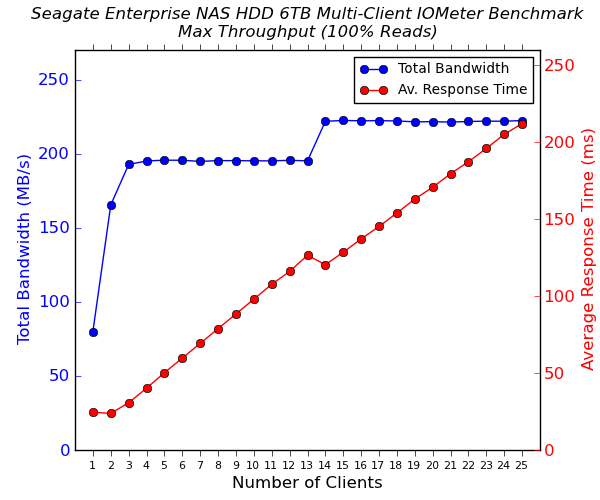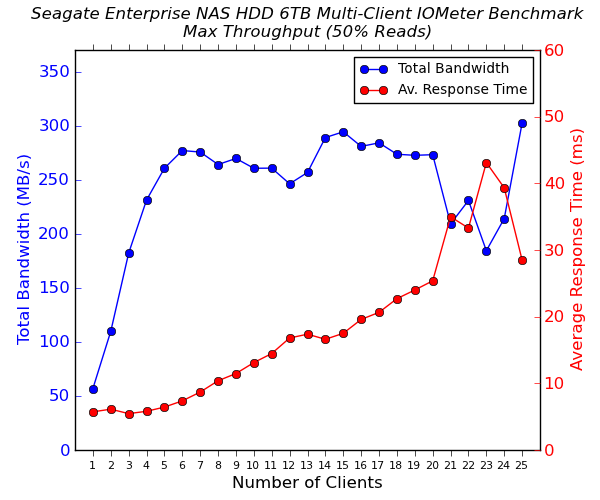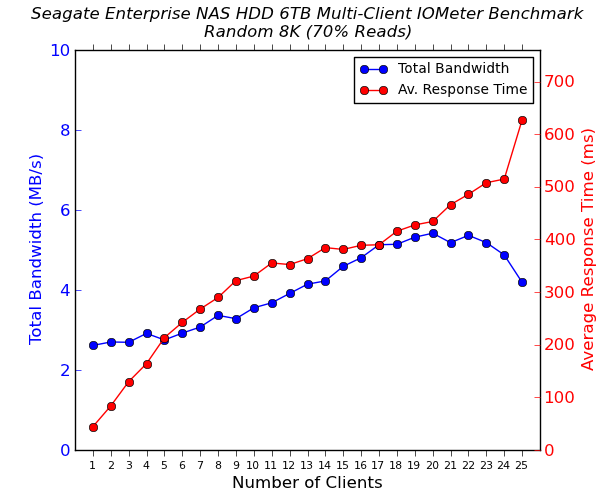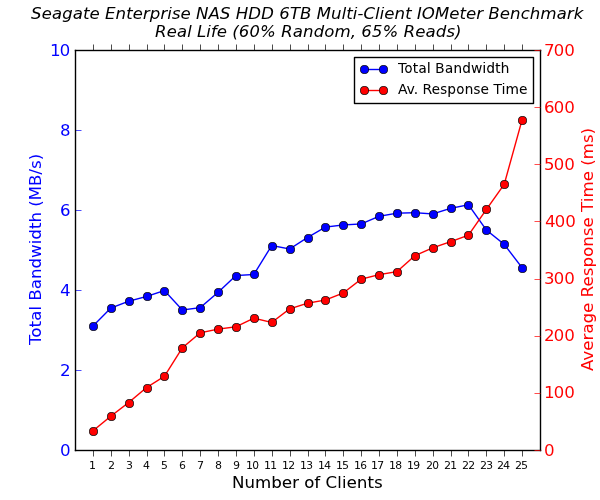Seagate Enterprise NAS HDD 6 TB Review
by Ganesh T S on December 10, 2014 8:00 AM EST- Posted in
- NAS
- Storage
- Seagate
- HDDs
- Enterprise
Multi-Client Access - NAS Environment
We configured three of the Seagate Enterprise NAS HDD drives in a RAID-5 volume in the QNAP TS-EC1279U-SAS-RP. A CIFS share in the volume was subject to some IOMeter tests with access from up to 25 VMs simultaneously. The following four graphs show the total available bandwidth and the average response time while being subject to different types of workloads through IOMeter. IOMeter also reports various other metrics of interest such as maximum response time, read and write IOPS, separate read and write bandwidth figures etc. Some of the interesting aspects from our IOMeter benchmarking run are available here.




We see that the sequential accesses are still limited by the network link, but, this time, on the NAS side. On the other hand, our random access tests show markedly better performance for enterprise drives. From a viewpoint of the average access times, the Seagate Enterprise Capacity v4, Seagate Enterprise NAS HDD and the HGST Ultrastar He6 all fall in the same category. Amongst these three, the Enterprise NAS HDD doesn't win out on any particular benchmark. However, that is to be expected - the other drives that are in the comparison list are targeted towards true enterprise-class / datacenter applications.










51 Comments
View All Comments
cm2187 - Wednesday, December 10, 2014 - link
+1MikeMurphy - Wednesday, December 10, 2014 - link
Exactly.tocker - Wednesday, December 10, 2014 - link
We could place bets. I'm going for a 40% failure rate inside of 3 years.Thats probably being generous.
Laststop311 - Thursday, December 11, 2014 - link
https://www.backblaze.com/blog/hard-drive-reliabil...Hitachi has the lowest failure rate in a massively huge deployment of HDD's in a cloud storage facility. Gives you a pretty good idea just how amazing they are.
ddriver - Sunday, December 14, 2014 - link
Yeah, but that's not a given, remember back in the days where those same deskstar disks were called deathstar cuz they were dropping down life flies?It would be nice of more cloud storage provides post their stats so that regular people know what to buy.
Zap - Wednesday, December 10, 2014 - link
What RPM are these drives? I know manufacturers like to obfuscate this information, but as a consumer I'd like to know.wavetrex - Wednesday, December 10, 2014 - link
That raw read/write speed is typical for 1TB platters on a 7200rpm drive.My guess is that speed is the comfort zone for these drives, and they probably spin down to 5400 when idling to reduce power consumption
MrSpadge - Wednesday, December 10, 2014 - link
No matter what WD likes to tell you with "IntelliPower" etc. drives do not normally run at different speeds. The mechanics, head aerodynamics / fly height and everything must be tailored to a specific spindle speed. Changing it on the fly has so far been unfeasible and wouldn't be much quicker than simply spinning down at idle, yet provide a only a small fraction of the power savings.hlmcompany - Wednesday, December 10, 2014 - link
IntelliPower and WD don't say that the drive changes speed during operation. An IntelliPower drive is a fixed speed, but set to meet certain power requirements. Because of this not all IntelliPower drives are at the same spindle speed.http://wdc.custhelp.com/app/answers/detail/a_id/36...
Navvie - Wednesday, December 10, 2014 - link
When 'IntelliPower' was first introduced WD were very secretive about exactly what it meant. Although there are now sources, their vague comments on exactly what IntelliPower is lead people to the conclusion that the drives were adjusting speed depending on demand.I believe the clever guys at SPCR were the first to determine the speed of IntelliPower drives by looking at the drives harmonics.